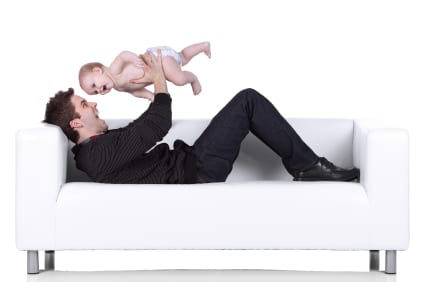Babies love to be played with and also should be encouraged to play alone. Although not yet capable of engaging in play with other children until the age of 12-18 months, babies love to watch older children play and be the object of (massive amounts of) affection. Cuddles, “raspberries” on the tummy and peek-a-boo are examples of ways an adult or older child can play with a baby. Passive forms of entertainment, such as watching a mobile or enjoying a small dose of a developmentally appropriate video, are also opportunities for babies to benefit from play.
To this day, my kids love when we pretend we each are a pizza maker and a pizza–we roll each other out on the ground, spread out cheese toppings (tickling), flatten each other out and then gobble each other up! That was a baby game, that became a silly, goofy family tradition. (I promise, kiddos, I won’t do that at your weddings!)
Physical Movements & Play
As physical movements become more coordinated and baby muscles strengthen, babies are able to open and shut their fists and can hold a rattle if it is placed inside her hands. Even the youngest baby will reflexively grasp something that is placed in the palm of her hand. They lose this ability around three months, which is when they begin to develop intentional grasping habits.
Babies can also be very silly. As they begin to explore their surroundings and get comfortable with their movements, they may grasp, reach or swat at a colorful object (such as a toy) or even at their mommy’s face. Babies will also look at their own hands and feet and play with their fingers as a source of amusement. This is all part of getting to know their physical space.
Cause & Effect
Around six months old, your baby will make the association that by shaking her hand while holding a rattle means making noises. Play provides many opportunities for him make discoveries with his own toys. If you pay close attention, you’ll find that babies are more apt to explore and discover how a toy will work without your assistance. Studies have found that a baby’s sense of exploration is limited and interest declines when he is shown how a toy works.
By providing toys that are have sounds, lights or other rewards associated with pressing buttons or textures, you encourage your little one to explore this whole new world of cause and effect.





